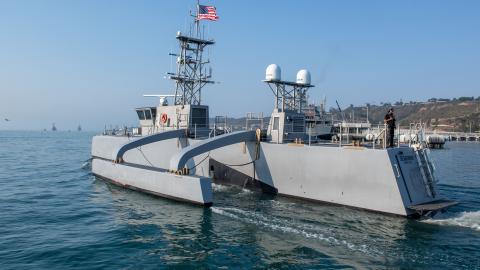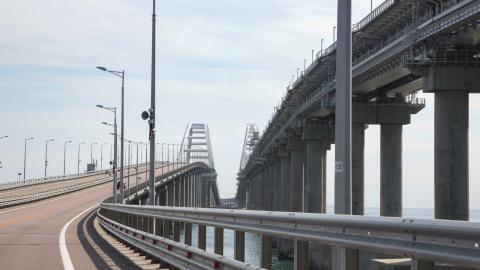Since Russia’s large-scale invasion of Ukraine in February 2022, Ukrainians have demonstrated remarkable creativity, ingenuity, and adaptability on the modern battlefield. Their innovations in disruptive military technologies and asymmetric concepts of operations have not only disrupted Russian combat operations but have also helped Kyiv’s North Atlantic Treaty Organization partners better understand twenty-first-century conflict. Ukraine has repeatedly proven its ability to innovate under pressure, such as by using first-person view drones against a broad target-set, resorting to crowd-sourced aerial attack monitoring apps to protect civilians, mounting cell phones onto poles to detect incoming Russo-Iranian Shahed drones, and deploying autonomous maritime drones to inflict substantial damage and restrict the Russian Black Sea Fleet’s freedom of movement. Most impressively, Ukraine has rapidly expanded its offensive robotic aerial capabilities, which have enabled it to strike deep inside Russia and target the defense industrial base and hydrocarbon industry that keep Vladimir Putin’s war machine in the fight.
Operation Spiderweb illustrated this battlefield ingenuity in June when Ukraine covertly launched unmanned aerial systems from tractor trailers to strike key strategic aviation assets at multiple Russian air bases. In just a few hours, a significant percentage of Russia’s nuclear-capable strategic air wings were damaged or destroyed, demonstrating Ukraine’s expanding reach and effectiveness.
The following list outlines eight high-value and militarily plausible targets that Ukraine should pursue to weaken Russia’s warfighting ability and increase the political cost of invading and occupying Ukrainian territory. Military planners in Kyiv are already familiar with the items on this list—and have exploited many of them in a limited form or are attempting to do so—but American policymakers should be aware of them, too. While a single strike against any one of these targets would not by itself constitute a decisive blow, cumulatively, a sustained attack against several of them could significantly damage Russia’s military infrastructure and complicate its continued aggression. Moreover, when appropriate, the United States and Ukraine’s other NATO partners should support and enable such operations.
1. The Volga–Don Canal
Target: One of two canals connecting the Caspian and Black Seas via the Sea of Azov, the Volga–Don Canal is 63 miles long and, as the name suggests, connects the Don and Volga Rivers. It primarily handles commercial transportation. However, during the spring and summer months when the canal is not frozen, Russia uses it to move warships and military supplies between the Caspian and Black Seas. For example, Moscow can only reinforce the Black Sea Fleet by transferring vessels from the Russian Caspian Flotilla, which has played a direct role in supporting Russia’s invasion, ever since Turkey closed the Turkish Straits to military ships. Meanwhile, missiles and other materiel from the Islamic Revolutionary Guards Corps (IRGC) that help Russia in Ukraine also arrive through the canal.
Realizing how important the canal is, Moscow recently announced a $1 billion investment to modernize the waterway. Not only will this make the canal more dependable for moving logistics and operations, but it will also increase trade opportunities with Iran.
Key Vulnerabilities: The Volga–Don Canal consists of 13 locks—nine on the Volga slope and four on the Don slope—and several represent critical vulnerabilities. Near Volgograd, Lock 1 connects the canal to the Volga River, while Lock 13, near Kalach-na-Donu, connects it to the Don River; they serve as the canal’s entry and exit points. Additionally, Locks 8 and 9 are situated at the canal’s highest elevation, near the watershed dividing the Caspian and Black Sea basins. Severe damage to any lock would shut down the entire system and sever east–west navigation, albeit temporarily. However, damage or destruction of Locks 8 or 9 would be especially disruptive, as they control the most hydraulically sensitive section of the canal. Located at the artificial summit, they rely on reservoirs and pumping systems rather than natural inflow, meaning their failure would not only halt transit but also compromise the canal’s internal water balance. Repairing or bypassing this section would be far more complex than elsewhere, making it a critical operational chokepoint. Nonetheless, Ukraine will need considerable precision and warhead firepower to significantly damage the locks. Russian air defenses are unlikely to be very dense in the area, so command and control of the strike package and coordination of the attack would be the chief hurdles.
Potential Impact: A successful strike would deal a major geopolitical blow to Russia as well as to the Islamic Republic. Movement of military and commercial vessels between the Caspian and Black Sea would also slow and halt, causing economic disruption.
Map 1. Key Locks Along the Volga–Don Canal
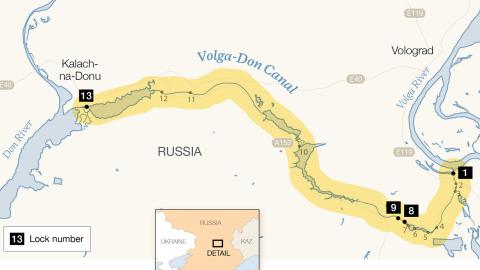
Source: Hudson Institute research
2. Joint Russo-Iranian Shahed Drone Plant in Tatarstan
Target: At the Alabuga Special Economic Zone in Yelabuga, Tatarstan, roughly 900 miles from Ukraine, Moscow and Tehran built a first-in-kind Shahed drone manufacturing facility. This factory is the central hub for Russia’s domestic production of Iranian-designed Shahed-131, Shahed-136, and Shahed-238 loitering munitions—which Moscow rebranded as the Geran-1, Geran-2, and Geran-3, respectively—as well as the Gerbera line of Shahed decoys.
Open-source reporting indicates that most of Russia’s Shahed drones come from this facility, making it a legitimate military target. The factory’s likely daily production of 170 to 190 Shaheds supports massive salvos,[7] which can reach up to 700 drones and may increase to 2,000 by the end of 2025. In June 2025 alone, Russia launched some 5,500 Shahed drones at Ukrainian population centers.[8] If left operational, the Tatarstan drone factory will churn out thousands of drones that will further saturate Ukrainian air defenses. For the sake of its national security, Kyiv needs to target the facility.
While Ukraine has struck the plant in the past, those attacks were limited and inflicted only modest damage. Furthermore, the plant is now much larger and has been through systematic enhancements, and other Shahed drone plants are under construction elsewhere in Russia and probably in Belarus very soon. So a more sustained campaign will be required to disrupt industrial output seriously, as any large-scale, one-and-done strike will not be enough. Such a campaign will also require a sufficiently powerful warhead. Previously, modified hobby aircraft (e.g., the Aeroprakt A-22) proved to have the range to target the plant, but they lacked the destructive capability to halt drone production permanently.
Finally, Russia encourages young workers to build drones at the Tatarstan factory—including students from Alabuga Polytechnic College, members of student unions, and women from poor countries who participate in the Alabuga Start program. The site also uses forced labor from Turkic Tatars. Satellite images show dormitories for up to 41,000 people living at the plant.[9] So distinguishing between any North Korean workforce, IRGC liaison personnel, and young workers would be very difficult, if not impossible. Striking the facility with devastating firepower might thus result in significant collateral damage. Hitting the facility’s power supply instead could be another option.
Key Vulnerabilities: The factory draws electricity primarily from the Tatarstan power grid, most likely sourced from the Nizhnekamsk Thermal Power Plant—a major generator in the region. Any disruption to this regional energy network could impact factory operations. Additionally, laborers may not report to work if the facility were to face a significant threat.
Potential Impact: While destruction of the facility is not possible, even a partial disruption would represent a symbolic victory for Ukraine and a practical blow to Russia’s drone capabilities. It would also warn Tehran not to support Russian attacks against Ukraine.
Map 2. Drone Production Site in Tatarstan
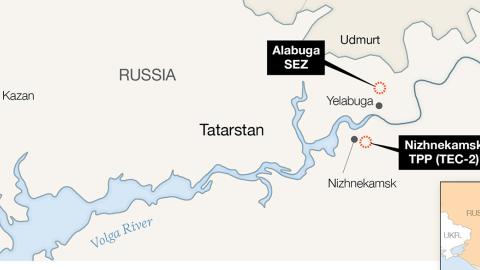
Source: Hudson Institute research
3. China–Russia Land Transit Routes
Target: Although China remains publicly neutral regarding Russia’s invasion of Ukraine, Beijing has no doubt enabled Moscow’s war effort. While much of the international community sought to isolate Russia, bilateral trade between China and Russia has soared to record highs, surpassing $240 billion annually.
China’s exports of crucial electronics and semiconductors, many of which have dual-use potential, are particularly concerning. According to US and European intelligence reports, evidence indicates that China has supplied Russia with drones and drone components, navigation and optics equipment, and a variety of materials used in munitions and weapons production—including ball bearings, microchips, and other industrial inputs.
China’s exports to Russia are mostly transported over land, primarily through two major border crossings in the Russian Far East: Manzhouli–Zabaykalsk and Suifenhe–Pogranichny. Roughly 90 percent of this overland trade is carried by rail, and about 60 percent of those rail shipments pass through the Manzhouli–Zabaykalsk crossing alone.
Key Vulnerabilities: Due to geopolitical sensitivities, Ukraine—or Ukraine-aligned forces operating inside Russia—would understandably refrain from directly targeting these two border crossings. However, there are several vulnerable and critical transit choke points within a 100-mile radius on the Russian side of each crossing. An attack on these could lead to severe disruptions.
These infrastructure nodes—such as bridges, railyards, junctions, and traffic choke points—are on Russian territory and support the steady flow of dual-use goods from China. These locations could present viable targets for sabotage or disruption, which would degrade Russia’s logistics capacity without directly implicating Ukraine or risking significant diplomatic fallout with Beijing.
Potential Impact: Any disruption to the rail or road infrastructure on the Russian side of either crossing could significantly delay the flow of critical dual-use goods from China. While such disruptions would carry geopolitical sensitivities—especially given Ukraine’s complex relationship with China—they represent a potentially effective pressure point. Covert operations inside Russia, rather than overt military strikes, would be better suited to exploit these vulnerabilities while preserving plausible deniability and limiting diplomatic fallout.
Map 3. Strategic Border Crossings Between China and Russia in the Far East
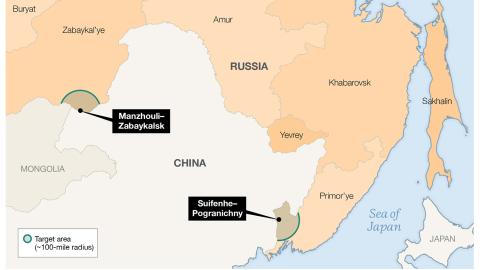
Source: Hudson Institute research
4. Crimea Access Routes (Kerch and Isthmus Bridges)
Target: Occupied Crimea is Russia’s key staging ground and resupply base for operations in southern Ukraine, so Ukraine needs to deny Russia the freedom to operate from Crimea. Military planners in Kyiv understand this fact, and they have repeatedly targeted Russia’s most valuable asset on the peninsula: the Kerch Bridge. Ukrainian forces have successfully hit this bridge three times, but it has not been destroyed, even if use of the bridge was disrupted temporarily.
The West should prioritize arming Ukraine with the weapons it needs to destroy, or at least incapacitate, the Kerch Bridge. The German Taurus missile, with its smart fuse technology and destructive warhead, remains the ideal weapon for this operation. In addition to the Kerch Bridge, the West should assist Ukraine in targeting key transit nodes connecting occupied Crimea with occupied Kherson Oblast. In particular, Ukraine should destroy or severely damage the Chonhar, Syvash, and Henichesk Bridges:
- Chonhar Bridge: This road bridge is one of the most strategically significant links between occupied Crimea and Kherson Oblast. The Chonhar Bridge is the most direct road route for Russia to move military forces, supplies, and equipment from Crimea into northern Kherson Oblast and onward to Melitopol and Zaporizhzhia.
- Syvash Bridge:An older rail bridge west of the Chonhar Bridge. The Syvash Bridge is the most direct road route for Russia to move military forces, supplies, and equipment from Crimea into northern Kherson Oblast and onward to Melitopol and Zaporizhzhia.
- Henichesk Bridge: This road bridge connects the Arabat Spit in northeastern Crimea to the town of Henichesk in occupied Kherson Oblast. After the liberation of Kherson, Henichesk became a key focal point for the Russian military. The bridge and the surrounding area are thus heavily defended, even though the Chonhar Bridge offers a more direct connection.
Key Vulnerabilities: All these bridges between Crimea and Kherson Oblast are closer to Ukrainian positions, structurally weaker, and less defended than the Kerch Bridge. The Chonhar and Syvash Bridges cross a narrow strip of land through the Syvash lagoon system and are surrounded by marshy land, putting both in a geographic choke point. Henichesk Bridge is the most defended and protected of the Crimea–Kherson Oblast bridges. (Ukraine successfully hit the Chonhar Bridge in 2023 with a Storm Shadow missile, which only caused temporary damage.
Potential Impact: Because these are important links connecting Russia to the occupied Crimean Peninsula and then onto occupied Kherson Oblast, rendering the Chonhar, Syvash, Henichesk, and Kerch Bridges impassable would put enormous pressure on Russia’s overland route to Crimea that runs through the occupied cities of Mariupol and Melitopol.
Map 4. Key Bridges Near Crimea
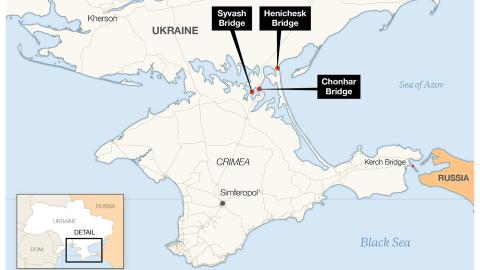
Source: Hudson Institute research
5. Key Rail Bridges in the Western Military District
Target: Russian railways, a linchpin in Putin’s invasion campaign across the former Soviet space, represent a critical vulnerability. Open-source intelligence indicates that Russian fuel trains are enormous, typically consisting of 40 to 60 cars per convoy. These freight trains average a speed of just 25 miles per hour, underscoring their susceptibility to interdiction if effectively targeted.
On any given day, Russia’s railway network transports between 20,000 and 30,000 tons of ammunition and fuel to support its occupation forces. Each Russian division receives approximately 1,870 tons of cargo daily via logistics battalions—of which 680 tons are liquid fuel or lubricants. Notably, 25 to 50 percent of the total logistics flow is dedicated to ammunition, particularly for Russia’s extensive use of tube artillery and multiple-launch rocket systems (MLRS). But Ukraine has had difficulty hitting moving targets like trains. Although railway hubs offer static and easier targets for a missile salvo, the Russian Railway Troops have been very effective in repairing them since the war’s outset. So despite the importance of the Russian railways and trains, Ukrainian kinetic operations against them have remained limited.
Key Vulnerabilities: Railway bridges, transformers, and traction substations present the most vulnerable Russian targets for Ukraine. They are more difficult to repair than standard tracks and are less elusive than moving trains. A telling example is Ukraine’s March 2024 strike in Russia’s Samara Oblast, which demonstrated the feasibility and impact of targeting bridge infrastructure. In a follow-up operation in May 2024, Ukrainian forces successfully struck a critical rail line linking Oryol and Kursk— hitting the transformers and traction substations.
Potential Impact: A large-scale campaign targeting multiple railway bridges—and rendering them inoperable for an extended period—would significantly disrupt the flow of fuel and ammunition to Russian forces. In the aftermath of such strikes, cascading bottlenecks would likely emerge across the broader rail network, creating secondary targets of opportunity for follow-on attacks.
6. Emerging Russian Naval Base in Abkhazia (Ochamchire)
Target: Due to Ukraine’s successful strikes against the Black Sea Fleet in occupied Crimea, Moscow is relocating portions of its fleet to ports farther away. One new naval base, which Russia started constructing last year, will be at Ochamchire in Abkhazia, a Russian-occupied region of Georgia. According to the de facto leader of Abkhazia, Badra Gunba, Russia plans to open a “technical support base” here for its Black Sea Fleet.
This location is currently home to a coal terminal and a Russian Federal Security Service (FSB) coast guard detachment, meaning the facility is already a legitimate target for Ukraine. Ukrainian drone warfare assets enjoy the range to target the site, so Kyiv should take steps to either disrupt or prevent the base’s construction.
Key Vulnerabilities: The base’s location is vulnerable due to the relatively flat and open coastline around Ochamchire, which offers minimal natural defensive barriers. Moreover, satellite imagery reveals no evidence of hardened shelters, covered storage, or deployed air defense systems, leaving the site exposed to aerial surveillance and potential strikes. The absence of camouflage or infrastructure dispersion further increases the vulnerability of fixed assets.
The base almost certainly relies on the local Abkhaz power grid and civilian fuel supplies, both of which are likely fragile and easily disrupted. Additionally, a single access road and railway line connect the facility to the rest of occupied Abkhazia. Notably, several hundred meters from the base, the main rail line passes beneath a bridge supporting another railway line—creating a potential choke point. If targeted, disruption at this juncture could severely limit the movement of personnel, ammunition, and fuel. Such a scenario would impose significant logistical challenges that Moscow may not have adequately anticipated.
Potential Impact: At a minimum, targeting the base during its construction phase would delay Russia’s efforts to diversify and secure its naval presence in the Black Sea. Politically, it would mark a significant victory for Ukraine, demonstrating its expanding strategic reach against high-value Russian targets. Depending on the scale of the strike and the damage inflicted, it could halt the expansion of the base altogether.
Map 5. Russian-Occupied Abkhazia and the Port of Ochamchira
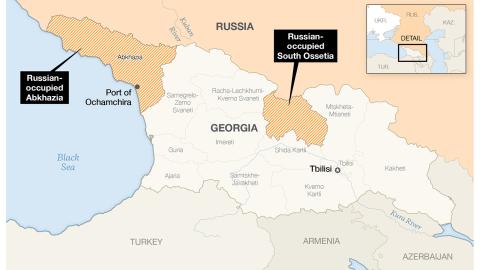
Source: Hudson Institute research
7. Transnistria
Target: In 1924, the region known today as Transnistria was largely within the borders of the Moldavian Autonomous Soviet Socialist Republic (ASSR) inside the Ukrainian Soviet Socialist Republic (SSR). Moscow removed the Moldavian ASSR from the Ukrainian SSR in 1940 and created the Moldavian SSR. In the early 1990s, a bloody war erupted between the new Republic of Moldova and the breakaway authorities in Transnistria, who wanted to form their own state. This dispute ended with Transnistria becoming a Russian-occupied de facto state that is still internationally recognized as part of Moldova. Today, many people in Transnistria hold multiple passports, including Moldovan, Romanian, Russian, and Ukrainian. Its ethnic and linguistic makeup includes Russians, Ukrainians, and Romanian Moldovans.
Since the end of the Transnistrian War in 1992, this small sliver of territory has consistently hosted Russian troops. In 1999, Russia agreed to remove all its forces and weaponry from Transnistria by the end of 2002. This did not happen. Currently, an estimated 1,500 Russian troops remain in Transnistria. When Russia wants to exert its influence in the region, this territory offers a good platform for it to do so.
Key Vulnerabilities: From a geostrategic standpoint, the Ukrainian military would enjoy the upper hand in any offensive against the Russian contingent in Transnistria. Since Moldova and Ukraine surround the region, the Kremlin cannot reinforce its forward-deployed troops there. The airfield in Transnistria is unusable, and Moldova scrutinizes its ports of entry for Russian soldiers trying to enter the territory in civilian guise. This puts the Kremlin’s forces in Transnistria, which include Russian officers and local conscripts, in limbo. Additionally, these forces operate old and dilapidated equipment.
Potential Impact: Ukraine would gain leverage in escalation dominance over the Kremlin by seizing Russian-held territory in Transnistria. In particular, such an operation would lessen the pressure on the key Ukrainian port city of Odesa. Before the war, the Kremlin amassed a large amphibious force from Kaliningrad, the Black Sea Fleet, and the Eastern Military District to seize Odesa. Ukrainian coastal defenses stymied the amphibious operation when it sank the Black Sea Fleet’s flagship Moskva in April 2022, but if the assault had occurred and succeeded, Russia could have attempted to link Odesa to Transnistria. Eliminating that option for Moscow by seizing Transnistria would relieve Ukraine in the long run. Of course, such a bold move would be risky. A large-scale strike could trigger a humanitarian situation in Moldova and neighboring Romania, and shelling near the Cobasna ammunition depot could prove very dangerous. But none of these risks are inevitable.
Map 6. Transnistria and the Moldova-Ukraine Border
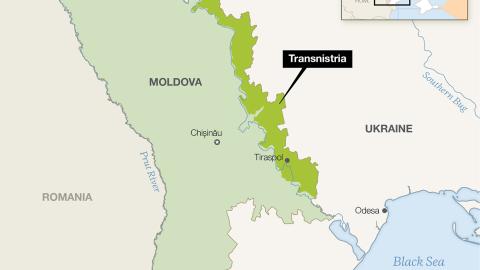
Source: Hudson Institute research
8. Russian Pacific Fleet Bases
Target: Russia’s Pacific Fleet and the marines from this sector have offered limited but notable support to Russia’s invasion, mostly by helping with logistics. Ships from the fleet have not been directly involved in the war, but its naval infantry units, particularly the 155th and 40th Naval Infantry Brigades, have served in Ukraine, notably in the south and east. For example, the former brigade is known for committing ethnic cleansing and systematic war crimes in Irpin and Bucha. The fleet has also transferred several vessels to reinforce the Black Sea Fleet—including landing ships and support craft—prior to and during the war’s early stages. Furthermore, the fleet ties down Western naval forces in the Indo-Pacific and participates in joint exercises with countries like China.
Key Vulnerabilities: While Russia’s Pacific naval bases have defenses, they probably do not match those surrounding the Black Sea Fleet, particularly when it comes to countering unmanned systems. However, unless Ukrainians develop a very creative plan, they lack the long-range strike capability to effectively target the Pacific naval bases. However, they should still try.
Ukrainian planners are very likely exploring options to containerize their seaborne drones—which have been highly effective against the Black Sea Fleet—and are considering innovative ways to deploy them in the Russian Far East. If Ukraine can discreetly place these systems aboard container ships, the vessels can approach Russian naval installations with minimal suspicion before launching an attack. Or Ukraine could use unmanned aerial systems, like in Operation Spiderweb, which would be a daring yet realistic option. Crucially, any such operation would need to be tightly controlled and plausibly deniable to manage escalation risks and preserve Ukraine’s strategic ambiguity.
Potential Impact: Such an ambitious attack could yield significant geopolitical dividends, even if not entirely successful. It would compel Russia to reassess its force protection posture across its entire naval fleet, including for assets located thousands of miles from Ukraine. In turn, the Kremlin would have to make difficult trade-offs in how it allocates defenses—potentially stretching its military thin. In the best-case scenario, any damaged or destroyed warship would become one less tool of aggression that Russia can deploy—whether against Ukraine or the West.
Map 7. Strategic Locations of Russia’s Pacific Fleet
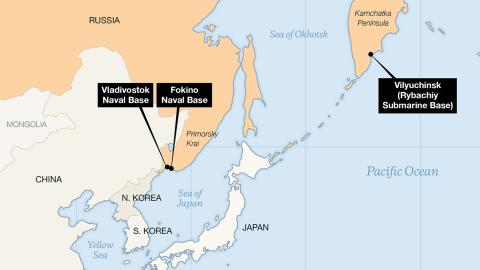
Source: Hudson Institute research
Map 8. Deep-Strike Targets for Ukraine
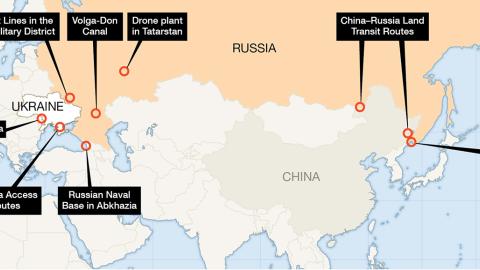
Source: Hudson Institute research












